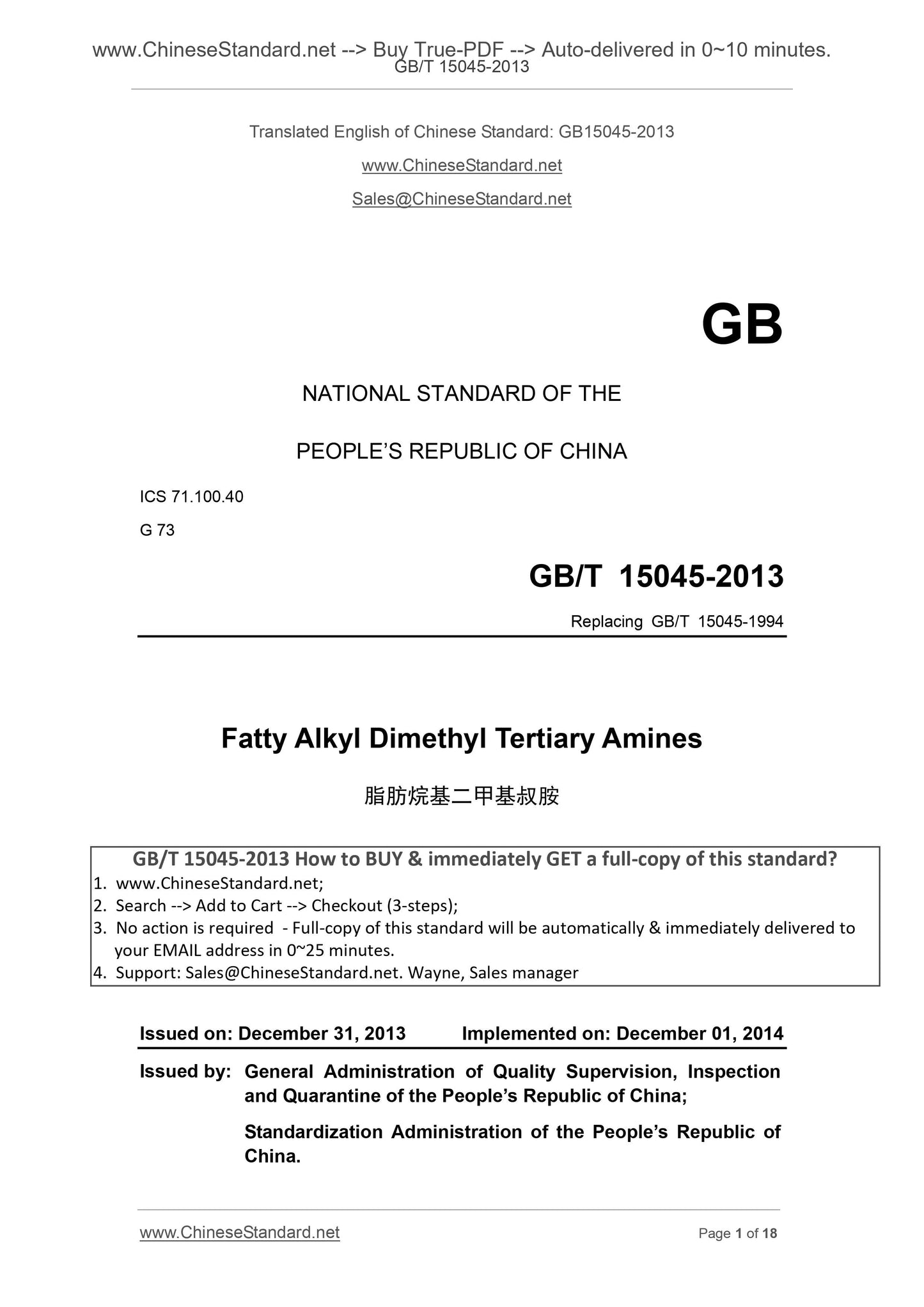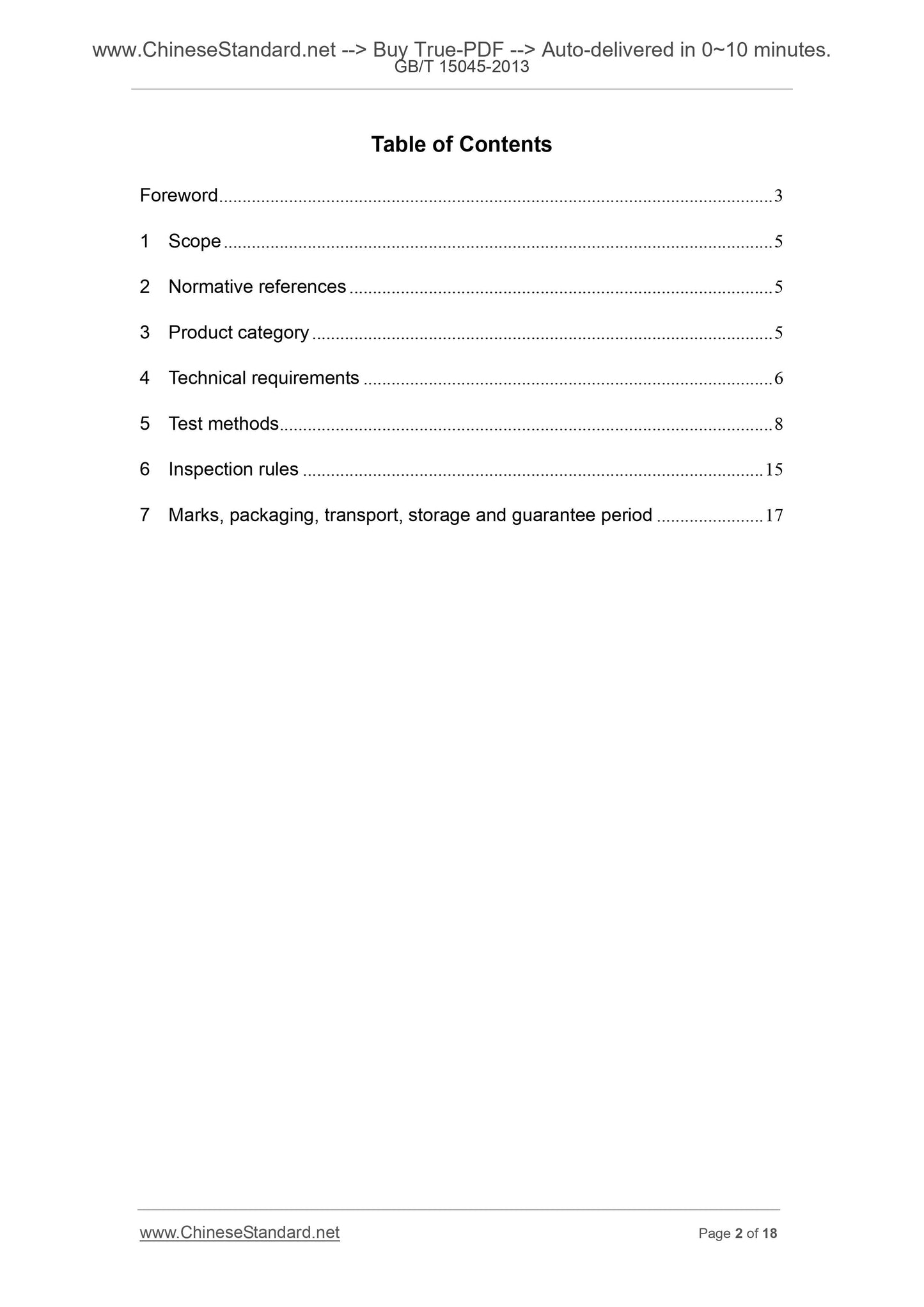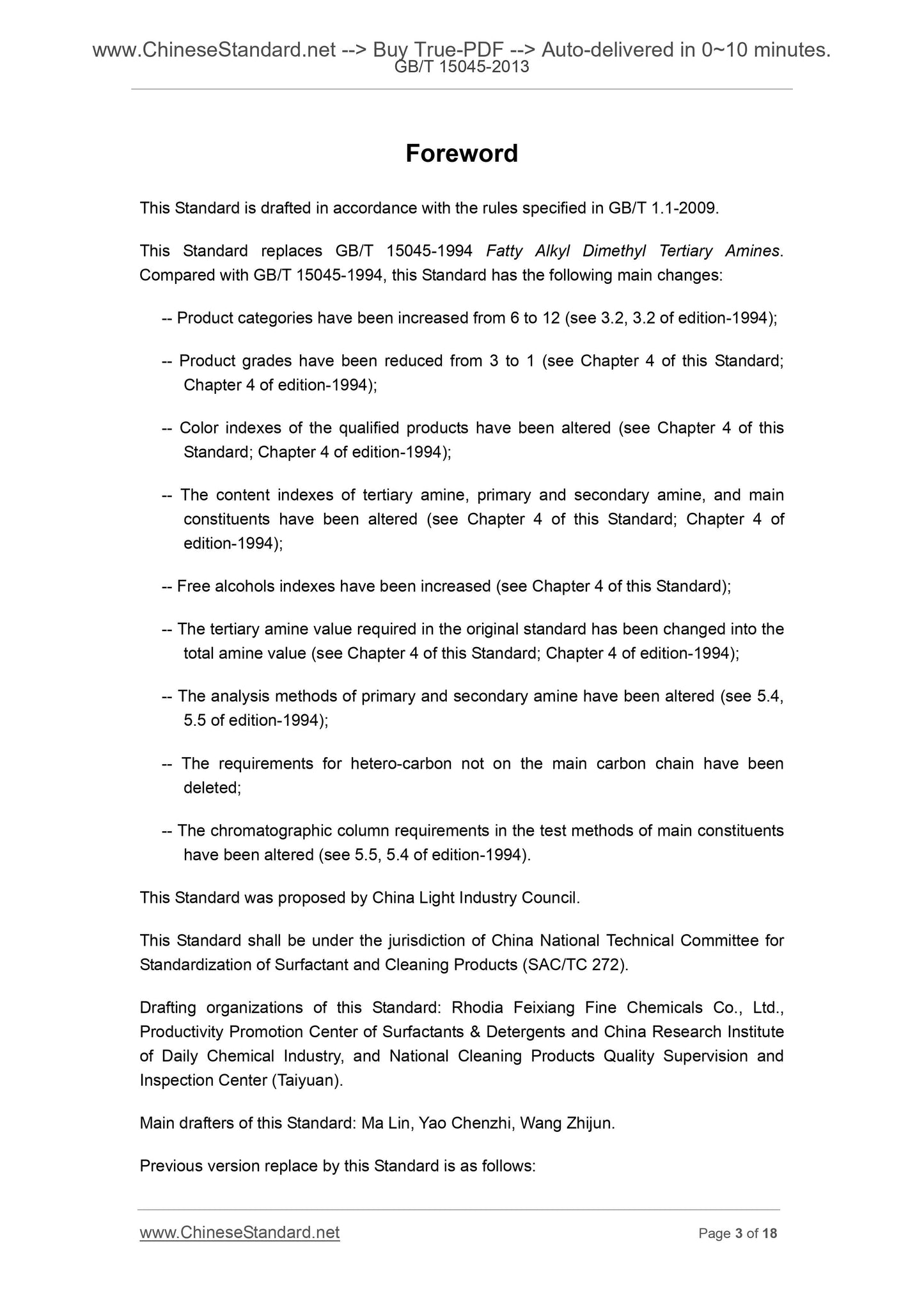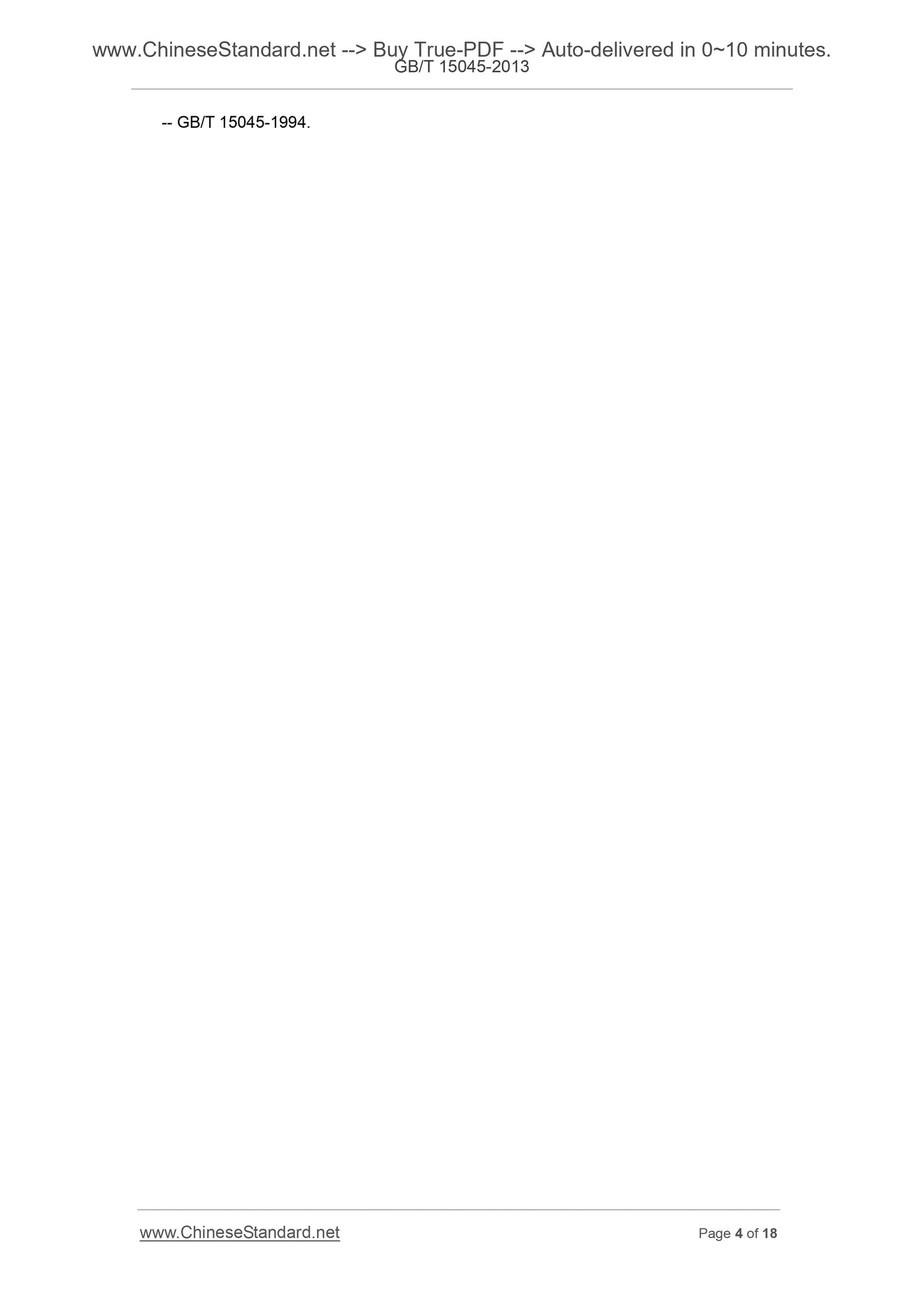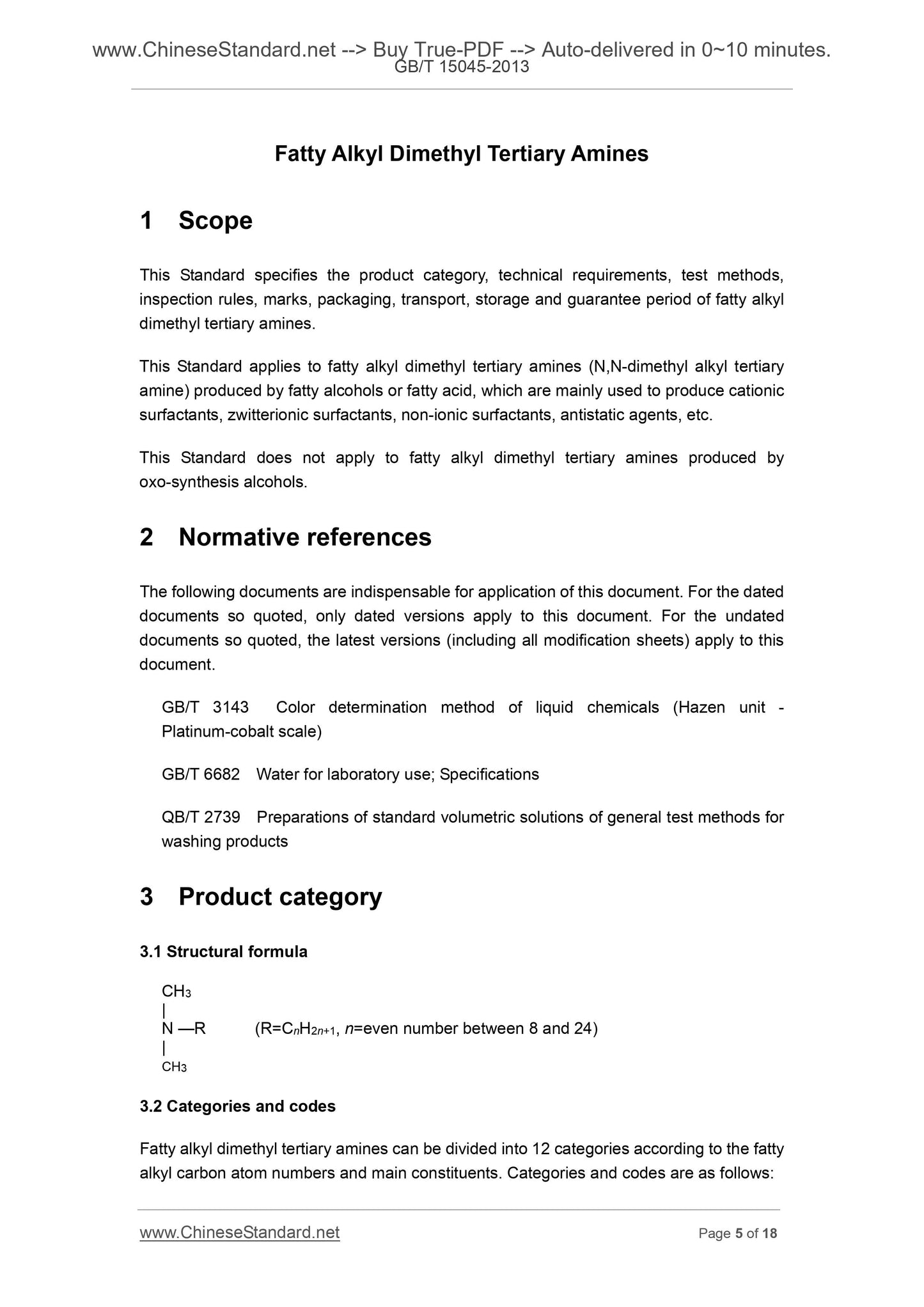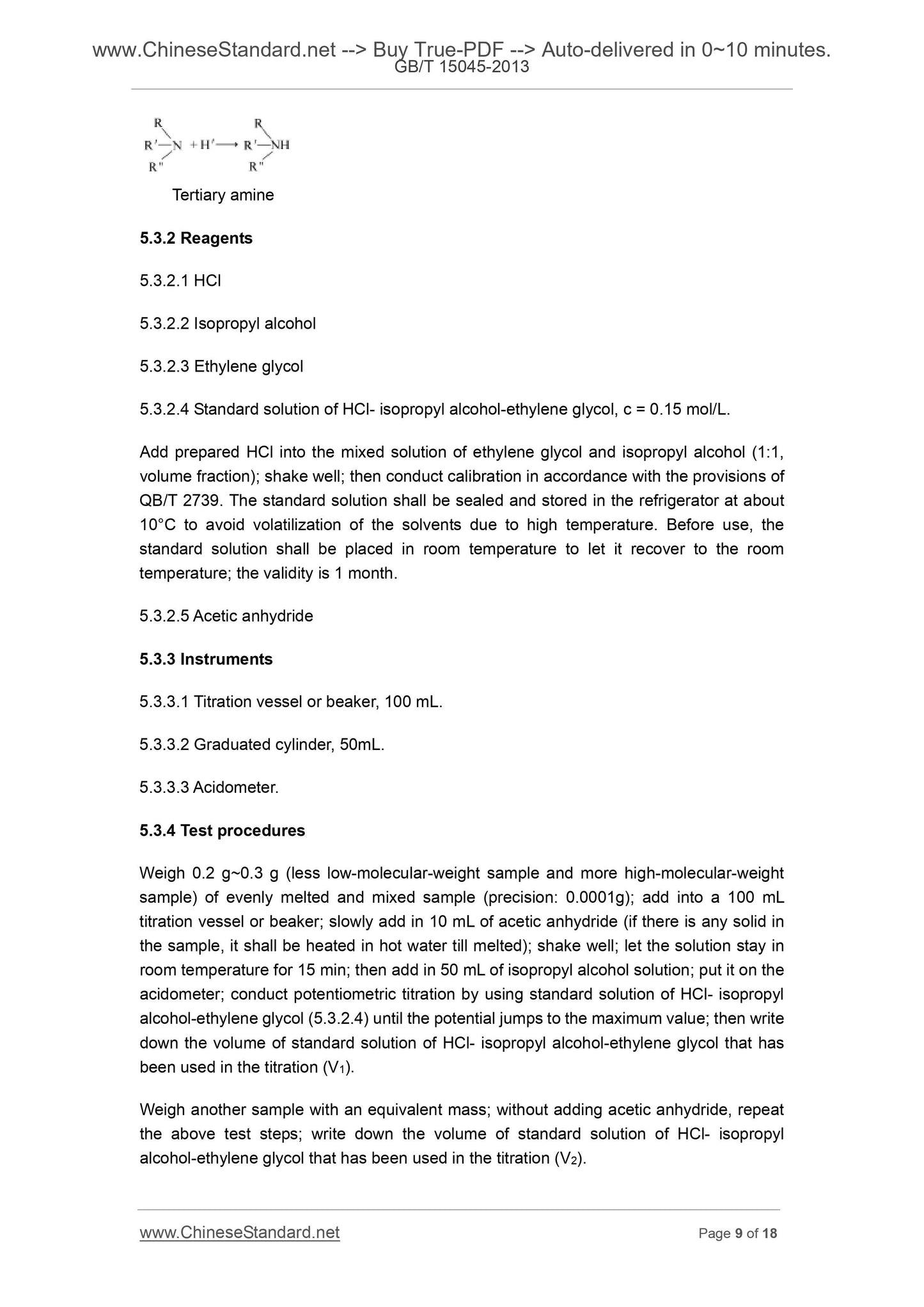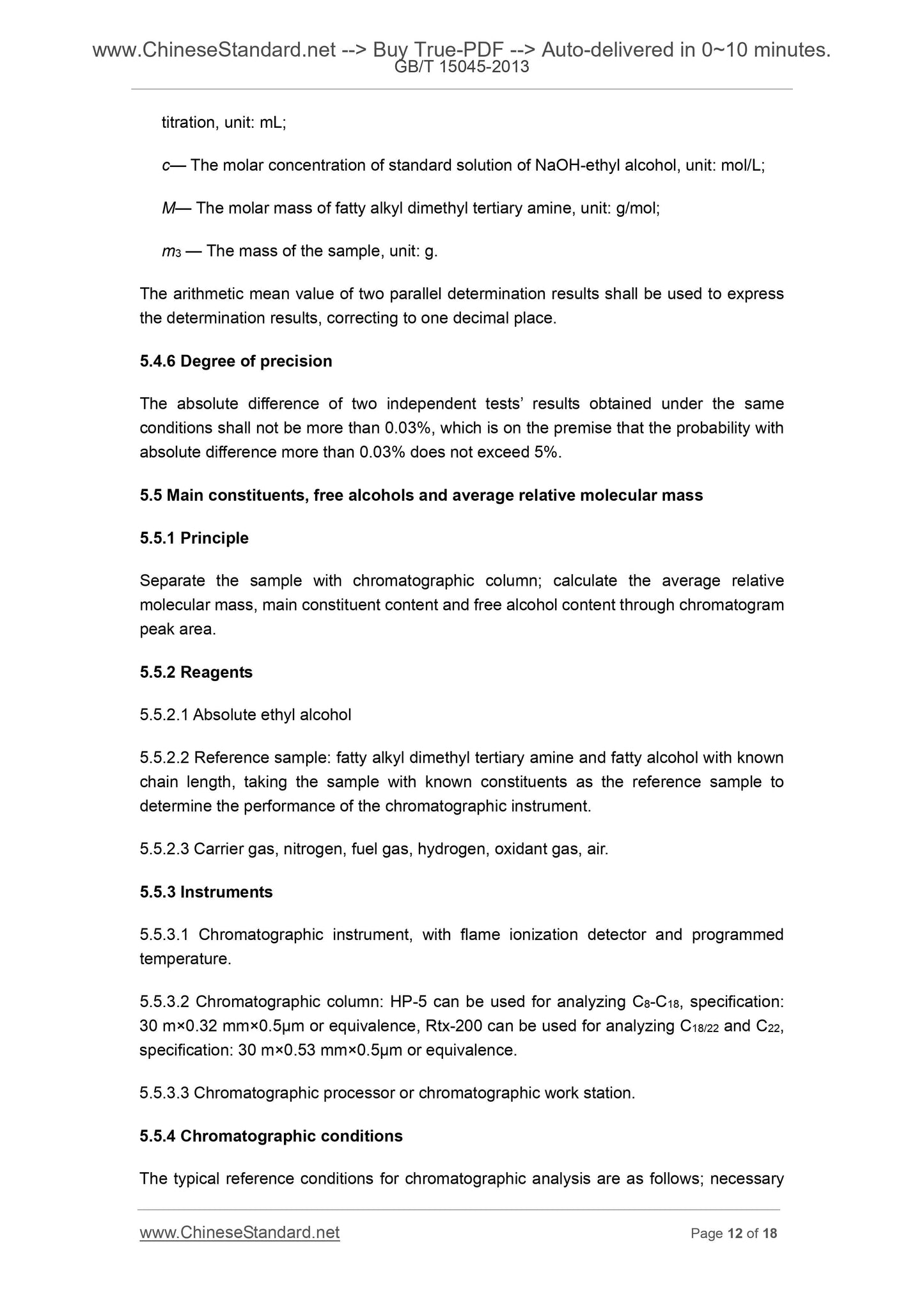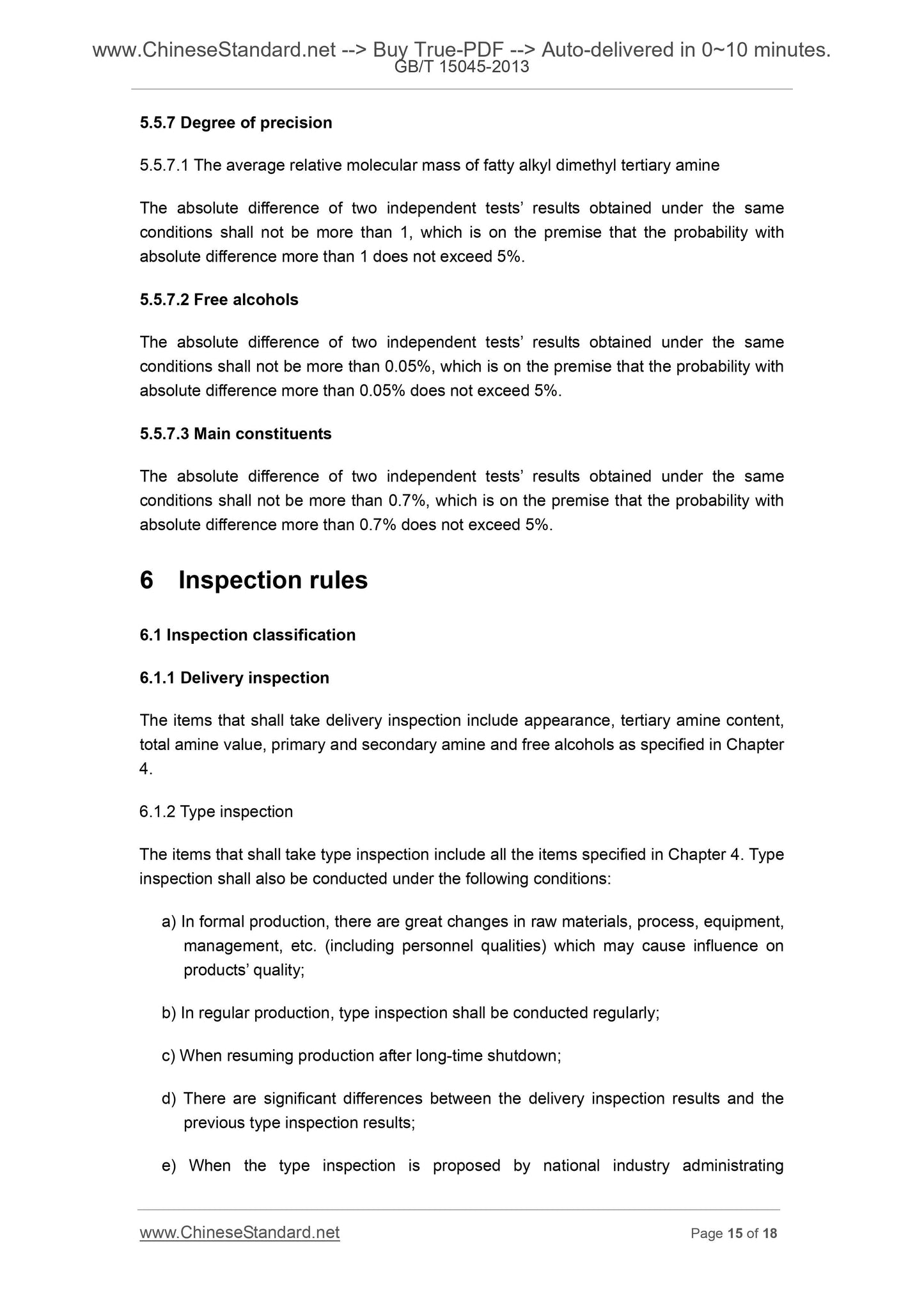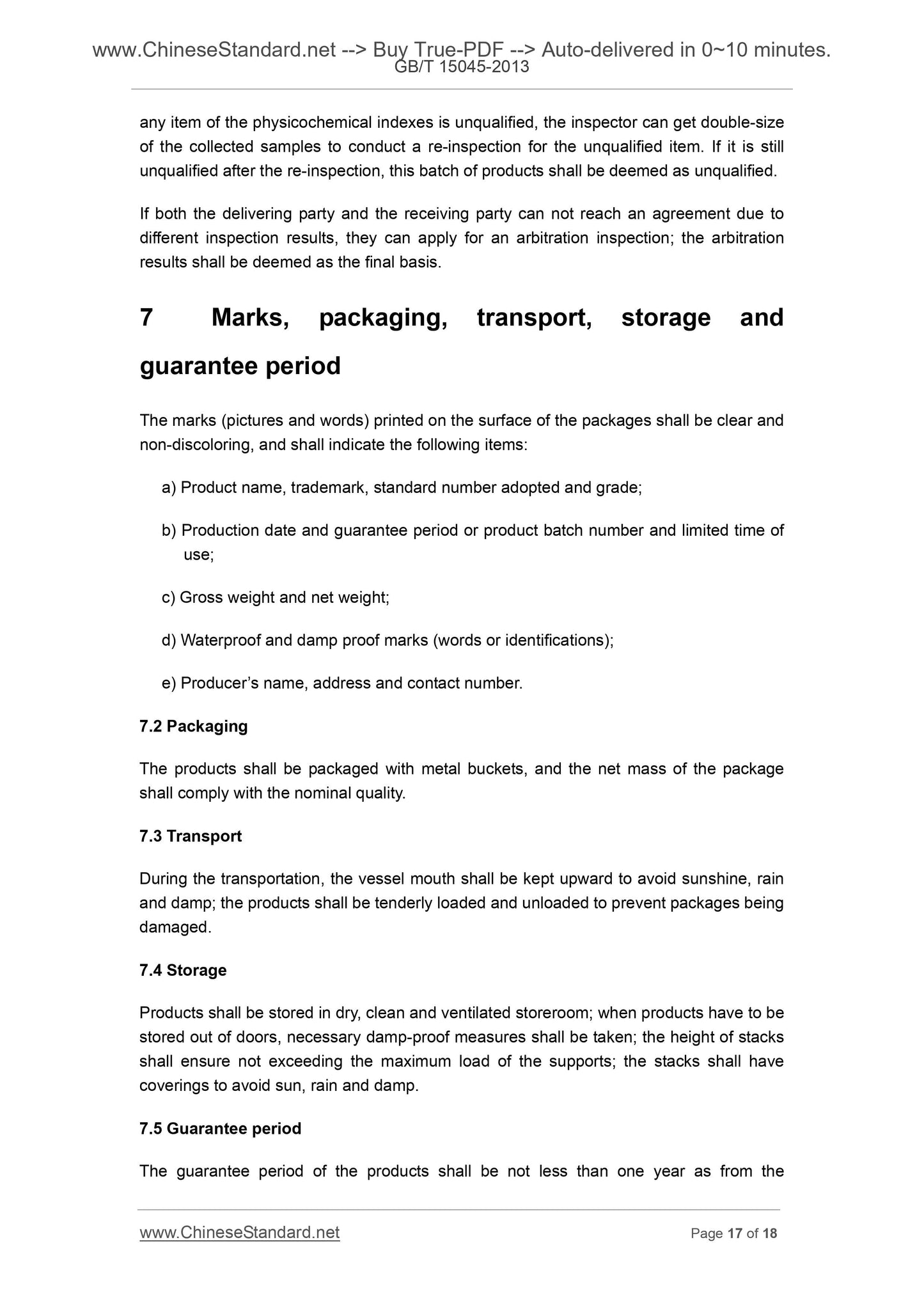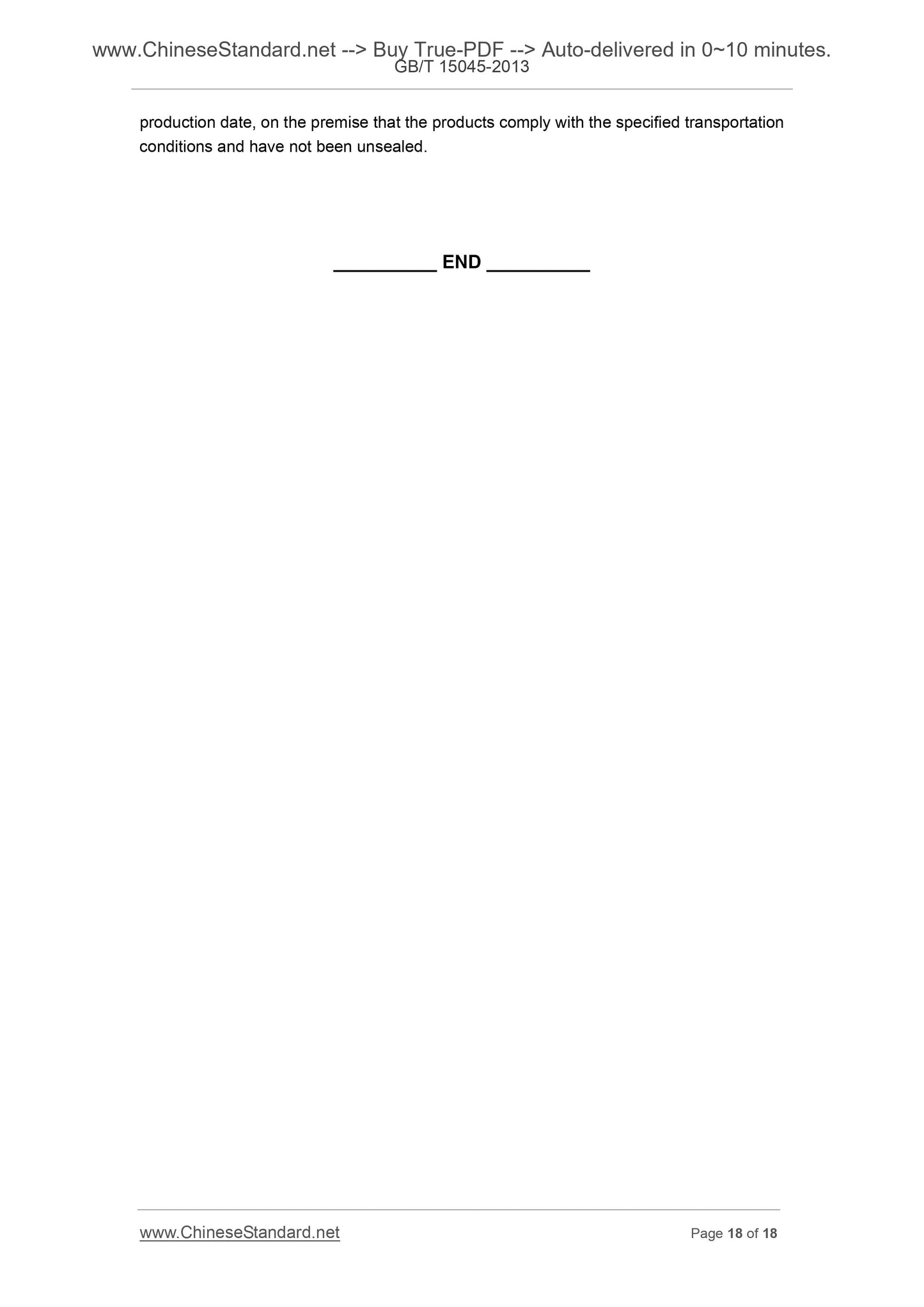1
/
of
10
www.ChineseStandard.us -- Field Test Asia Pte. Ltd.
GB/T 15045-2013 English PDF (GB/T15045-2013)
GB/T 15045-2013 English PDF (GB/T15045-2013)
Regular price
$130.00
Regular price
Sale price
$130.00
Unit price
/
per
Shipping calculated at checkout.
Couldn't load pickup availability
GB/T 15045-2013: Fatty alkyl dimethyl tertiary amines
Delivery: 9 seconds. Download (& Email) true-PDF + Invoice.
Get Quotation: Click GB/T 15045-2013 (Self-service in 1-minute)
Historical versions (Master-website): GB/T 15045-2013
Preview True-PDF (Reload/Scroll-down if blank)
GB/T 15045-2013
GB
NATIONAL STANDARD OF THE
PEOPLE’S REPUBLIC OF CHINA
ICS 71.100.40
G 73
Replacing GB/T 15045-1994
Fatty Alkyl Dimethyl Tertiary Amines
脂肪烷基二甲基叔胺
ISSUED ON. DECEMBER 31, 2013
IMPLEMENTED ON. DECEMBER 01, 2014
Issued by.
General Administration of Quality Supervision, Inspection
and Quarantine of the People’s Republic of China;
Standardization Administration of the People’s Republic of
China.
Table of Contents
Foreword ... 3
1 Scope ... 5
2 Normative references ... 5
3 Product category ... 5
4 Technical requirements ... 6
5 Test methods... 8
6 Inspection rules ... 15
7 Marks, packaging, transport, storage and guarantee period ... 17
Foreword
This Standard is drafted in accordance with the rules specified in GB/T 1.1-2009.
This Standard replaces GB/T 15045-1994 Fatty Alkyl Dimethyl Tertiary Amines.
Compared with GB/T 15045-1994, this Standard has the following main changes.
-- Product categories have been increased from 6 to 12 (see 3.2, 3.2 of edition-1994);
-- Product grades have been reduced from 3 to 1 (see Chapter 4 of this Standard;
Chapter 4 of edition-1994);
-- Color indexes of the qualified products have been altered (see Chapter 4 of this
Standard; Chapter 4 of edition-1994);
-- The content indexes of tertiary amine, primary and secondary amine, and main
constituents have been altered (see Chapter 4 of this Standard; Chapter 4 of
edition-1994);
-- Free alcohols indexes have been increased (see Chapter 4 of this Standard);
-- The tertiary amine value required in the original standard has been changed into the
total amine value (see Chapter 4 of this Standard; Chapter 4 of edition-1994);
-- The analysis methods of primary and secondary amine have been altered (see 5.4,
5.5 of edition-1994);
-- The requirements for hetero-carbon not on the main carbon chain have been
deleted;
-- The chromatographic column requirements in the test methods of main constituents
have been altered (see 5.5, 5.4 of edition-1994).
This Standard was proposed by China Light Industry Council.
This Standard shall be under the jurisdiction of China National Technical Committee for
Standardization of Surfactant and Cleaning Products (SAC/TC 272).
Drafting organizations of this Standard. Rhodia Feixiang Fine Chemicals Co., Ltd.,
Productivity Promotion Center of Surfactants and Detergents and China Research Institute
of Daily Chemical Industry, and National Cleaning Products Quality Supervision and
Inspection Center (Taiyuan).
Main drafters of this Standard. Ma Lin, Yao Chenzhi, Wang Zhijun.
Previous version replace by this Standard is as follows.
-- GB/T 15045-1994.
Fatty Alkyl Dimethyl Tertiary Amines
1 Scope
This Standard specifies the product category, technical requirements, test methods,
inspection rules, marks, packaging, transport, storage and guarantee period of fatty alkyl
dimethyl tertiary amines.
This Standard applies to fatty alkyl dimethyl tertiary amines (N,N-dimethyl alkyl tertiary
amine) produced by fatty alcohols or fatty acid, which are mainly used to produce cationic
surfactants, zwitterionic surfactants, non-ionic surfactants, antistatic agents, etc.
This Standard does not apply to fatty alkyl dimethyl tertiary amines produced by
oxo-synthesis alcohols.
2 Normative references
The following documents are indispensable for application of this document. For the dated
documents so quoted, only dated versions apply to this document. For the undated
documents so quoted, the latest versions (including all modification sheets) apply to this
document.
GB/T 3143 Color determination method of liquid chemicals (Hazen unit -
Platinum-cobalt scale)
GB/T 6682 Water for laboratory use; Specifications
QB/T 2739 Preparations of standard volumetric solutions of general test methods for
washing products
3 Product category
3.1 Structural formula
CH3
N —R (R=CnH2n+1, n=even number between 8 and 24)
CH3
3.2 Categories and codes
Fatty alkyl dimethyl tertiary amines can be divided into 12 categories according to the fatty
alkyl carbon atom numbers and main constituents. Categories and codes are as follows.
Tertiary amine
5.3.2 Reagents
5.3.2.1 HCl
5.3.2.2 Isopropyl alcohol
5.3.2.3 Ethylene glycol
5.3.2.4 Standard solution of HCl- isopropyl alcohol-ethylene glycol, c = 0.15 mol/L.
Add prepared HCl into the mixed solution of ethylene glycol and isopropyl alcohol (1.1,
volume fraction); shake well; then conduct calibration in accordance with the provisions of
QB/T 2739. The standard solution shall be sealed and stored in the refrigerator at about
10°C to avoid volatilization of the solvents due to high temperature. Before use, the
standard solution shall be placed in room temperature to let it recover to the room
temperature; the validity is 1 month.
5.3.2.5 Acetic anhydride
5.3.3 Instruments
5.3.3.1 Titration vessel or beaker, 100 mL.
5.3.3.2 Graduated cylinder, 50mL.
5.3.3.3 Acidometer.
5.3.4 Test procedures
Weigh 0.2 g~0.3 g (less low-molecular-weight sample and more high-molecular-weight
sample) of evenly melted and mixed sample (precision. 0.0001g); add into a 100 mL
titration vessel or beaker; slowly add in 10 mL of acetic anhydride (if there is any solid in
the sample, it shall be heated in hot water till melted); shake well; let the solution stay in
room temperature for 15 min; then add in 50 mL of isopropyl alcohol solution; put it on the
acidometer; conduct potentiometric titration by using standard solution of HCl- isopropyl
alcohol-ethylene glycol (5.3.2.4) until the potential jumps to the maximum value; then write
down the volume of standard solution of HCl- isopropyl alcohol-ethylene glycol that has
been used in the titration (V1).
Weigh another sample with an equivalent mass; without adding acetic anhydride, repeat
the above test steps; write down the volume of standard solution of HCl- isopropyl
alcohol-ethylene glycol that has been used in the titration (V2).
titration, unit. mL;
c— The molar concentration of standard solution of NaOH-ethyl alcohol, unit. mol/L;
M— The molar mass of fatty alkyl dimethyl tertiary amine, unit. g/mol;
m3 — The mass of the sample, unit. g.
The arithmetic mean value of two parallel determination results shall be used to express
the determination results, correcting to one decimal place.
5.4.6 Degree of precision
The absolute difference of two independent tests’ results obtained under the same
conditions shall not be more than 0.03%, which is on the premise that the probability with
absolute difference more than 0.03% does not exceed 5%.
5.5 Main constituents, free alcohols and average relative molecular mass
5.5.1 Principle
Separate the sample with chromatographic column; calculate the average relative
molecular mass, main constituent content and free alcohol content through chromatogram
peak area.
5.5.2 Reagents
5.5.2.1 Absolute ethyl alcohol
5.5.2.2 Reference sample. fatty alkyl dimethyl tertiary amine and fatty alcohol with known
chain length, taking the sample with known constituents as the reference sample to
determine the performance of the chromatographic instrument.
5.5.2.3 Carrier gas, nitrogen, fuel gas, hydrogen, oxidant gas, air.
5.5.3 Instruments
5.5.3.1 Chromatographic instrument, with flame ionization detector and programmed
temperature.
5.5.3.2 Chromatographic column. HP-5 can be used for analyzing C8-C18, specification.
30 m×0.32 mm×0.5μm or equivalence, Rtx-200 can be used for analyzing C18/22 and C22,
specification. 30 m×0.53 mm×0.5μm or equivalence.
5.5.3.3 Chromatographic processor or chromatographic work station.
5.5.4 Chromatographic conditions
The typical reference conditions for chromatographic analysis are as follows; necessary
5.5.7 Degree of precision
5.5.7.1 The average relative molecular mass of fatty alkyl dimethyl tertiary amine
The absolute difference of two independent tests’ results obtained under the same
conditions shall not be more than 1, which is on the premise that the probability with
absolute difference more than 1 does not exceed 5%.
5.5.7.2 Free alcohols
The absolute difference of two independent tests’ results obtained under the same
conditions shall not be more than 0.05%, which is on the premise that the probability with
absolute difference more than 0.05% does not exceed 5%.
5.5.7.3 Main constituents
The absolute difference of two independent tests’ results obtained under the same
conditions shall not be more than 0.7%, which is on the premise that the probability with
absolute difference more than 0.7% does not exceed 5%.
6 Inspection rules
6.1 Inspection classification
6.1.1 Delivery inspection
The items that shall take delivery inspection include appearance, tertiary amine content,
total amine value, primary and secondary amine and free alcohols as specified in Chapter
4.
6.1.2 Type inspection
The items that shall take type inspection include all the items specified in Chapter 4. Type
inspection shall also be conducted under the following conditions.
a) In formal production, there are great chang...
GB/T 15045-2013
GB
NATIONAL STANDARD OF THE
PEOPLE’S REPUBLIC OF CHINA
ICS 71.100.40
G 73
Replacing GB/T 15045-1994
Fatty Alkyl Dimethyl Tertiary Amines
脂肪烷基二甲基叔胺
ISSUED ON. DECEMBER 31, 2013
IMPLEMENTED ON. DECEMBER 01, 2014
Issued by.
General Administration of Quality Supervision, Inspection
and Quarantine of the People’s Republic of China;
Standardization Administration of the People’s Republic of
China.
Table of Contents
Foreword ... 3
1 Scope ... 5
2 Normative references ... 5
3 Product category ... 5
4 Technical requirements ... 6
5 Test methods... 8
6 Inspection rules ... 15
7 Marks, packaging, transport, storage and guarantee period ... 17
Foreword
This Standard is drafted in accordance with the rules specified in GB/T 1.1-2009.
This Standard replaces GB/T 15045-1994 Fatty Alkyl Dimethyl Tertiary Amines.
Compared with GB/T 15045-1994, this Standard has the following main changes.
-- Product categories have been increased from 6 to 12 (see 3.2, 3.2 of edition-1994);
-- Product grades have been reduced from 3 to 1 (see Chapter 4 of this Standard;
Chapter 4 of edition-1994);
-- Color indexes of the qualified products have been altered (see Chapter 4 of this
Standard; Chapter 4 of edition-1994);
-- The content indexes of tertiary amine, primary and secondary amine, and main
constituents have been altered (see Chapter 4 of this Standard; Chapter 4 of
edition-1994);
-- Free alcohols indexes have been increased (see Chapter 4 of this Standard);
-- The tertiary amine value required in the original standard has been changed into the
total amine value (see Chapter 4 of this Standard; Chapter 4 of edition-1994);
-- The analysis methods of primary and secondary amine have been altered (see 5.4,
5.5 of edition-1994);
-- The requirements for hetero-carbon not on the main carbon chain have been
deleted;
-- The chromatographic column requirements in the test methods of main constituents
have been altered (see 5.5, 5.4 of edition-1994).
This Standard was proposed by China Light Industry Council.
This Standard shall be under the jurisdiction of China National Technical Committee for
Standardization of Surfactant and Cleaning Products (SAC/TC 272).
Drafting organizations of this Standard. Rhodia Feixiang Fine Chemicals Co., Ltd.,
Productivity Promotion Center of Surfactants and Detergents and China Research Institute
of Daily Chemical Industry, and National Cleaning Products Quality Supervision and
Inspection Center (Taiyuan).
Main drafters of this Standard. Ma Lin, Yao Chenzhi, Wang Zhijun.
Previous version replace by this Standard is as follows.
-- GB/T 15045-1994.
Fatty Alkyl Dimethyl Tertiary Amines
1 Scope
This Standard specifies the product category, technical requirements, test methods,
inspection rules, marks, packaging, transport, storage and guarantee period of fatty alkyl
dimethyl tertiary amines.
This Standard applies to fatty alkyl dimethyl tertiary amines (N,N-dimethyl alkyl tertiary
amine) produced by fatty alcohols or fatty acid, which are mainly used to produce cationic
surfactants, zwitterionic surfactants, non-ionic surfactants, antistatic agents, etc.
This Standard does not apply to fatty alkyl dimethyl tertiary amines produced by
oxo-synthesis alcohols.
2 Normative references
The following documents are indispensable for application of this document. For the dated
documents so quoted, only dated versions apply to this document. For the undated
documents so quoted, the latest versions (including all modification sheets) apply to this
document.
GB/T 3143 Color determination method of liquid chemicals (Hazen unit -
Platinum-cobalt scale)
GB/T 6682 Water for laboratory use; Specifications
QB/T 2739 Preparations of standard volumetric solutions of general test methods for
washing products
3 Product category
3.1 Structural formula
CH3
N —R (R=CnH2n+1, n=even number between 8 and 24)
CH3
3.2 Categories and codes
Fatty alkyl dimethyl tertiary amines can be divided into 12 categories according to the fatty
alkyl carbon atom numbers and main constituents. Categories and codes are as follows.
Tertiary amine
5.3.2 Reagents
5.3.2.1 HCl
5.3.2.2 Isopropyl alcohol
5.3.2.3 Ethylene glycol
5.3.2.4 Standard solution of HCl- isopropyl alcohol-ethylene glycol, c = 0.15 mol/L.
Add prepared HCl into the mixed solution of ethylene glycol and isopropyl alcohol (1.1,
volume fraction); shake well; then conduct calibration in accordance with the provisions of
QB/T 2739. The standard solution shall be sealed and stored in the refrigerator at about
10°C to avoid volatilization of the solvents due to high temperature. Before use, the
standard solution shall be placed in room temperature to let it recover to the room
temperature; the validity is 1 month.
5.3...
Delivery: 9 seconds. Download (& Email) true-PDF + Invoice.
Get Quotation: Click GB/T 15045-2013 (Self-service in 1-minute)
Historical versions (Master-website): GB/T 15045-2013
Preview True-PDF (Reload/Scroll-down if blank)
GB/T 15045-2013
GB
NATIONAL STANDARD OF THE
PEOPLE’S REPUBLIC OF CHINA
ICS 71.100.40
G 73
Replacing GB/T 15045-1994
Fatty Alkyl Dimethyl Tertiary Amines
脂肪烷基二甲基叔胺
ISSUED ON. DECEMBER 31, 2013
IMPLEMENTED ON. DECEMBER 01, 2014
Issued by.
General Administration of Quality Supervision, Inspection
and Quarantine of the People’s Republic of China;
Standardization Administration of the People’s Republic of
China.
Table of Contents
Foreword ... 3
1 Scope ... 5
2 Normative references ... 5
3 Product category ... 5
4 Technical requirements ... 6
5 Test methods... 8
6 Inspection rules ... 15
7 Marks, packaging, transport, storage and guarantee period ... 17
Foreword
This Standard is drafted in accordance with the rules specified in GB/T 1.1-2009.
This Standard replaces GB/T 15045-1994 Fatty Alkyl Dimethyl Tertiary Amines.
Compared with GB/T 15045-1994, this Standard has the following main changes.
-- Product categories have been increased from 6 to 12 (see 3.2, 3.2 of edition-1994);
-- Product grades have been reduced from 3 to 1 (see Chapter 4 of this Standard;
Chapter 4 of edition-1994);
-- Color indexes of the qualified products have been altered (see Chapter 4 of this
Standard; Chapter 4 of edition-1994);
-- The content indexes of tertiary amine, primary and secondary amine, and main
constituents have been altered (see Chapter 4 of this Standard; Chapter 4 of
edition-1994);
-- Free alcohols indexes have been increased (see Chapter 4 of this Standard);
-- The tertiary amine value required in the original standard has been changed into the
total amine value (see Chapter 4 of this Standard; Chapter 4 of edition-1994);
-- The analysis methods of primary and secondary amine have been altered (see 5.4,
5.5 of edition-1994);
-- The requirements for hetero-carbon not on the main carbon chain have been
deleted;
-- The chromatographic column requirements in the test methods of main constituents
have been altered (see 5.5, 5.4 of edition-1994).
This Standard was proposed by China Light Industry Council.
This Standard shall be under the jurisdiction of China National Technical Committee for
Standardization of Surfactant and Cleaning Products (SAC/TC 272).
Drafting organizations of this Standard. Rhodia Feixiang Fine Chemicals Co., Ltd.,
Productivity Promotion Center of Surfactants and Detergents and China Research Institute
of Daily Chemical Industry, and National Cleaning Products Quality Supervision and
Inspection Center (Taiyuan).
Main drafters of this Standard. Ma Lin, Yao Chenzhi, Wang Zhijun.
Previous version replace by this Standard is as follows.
-- GB/T 15045-1994.
Fatty Alkyl Dimethyl Tertiary Amines
1 Scope
This Standard specifies the product category, technical requirements, test methods,
inspection rules, marks, packaging, transport, storage and guarantee period of fatty alkyl
dimethyl tertiary amines.
This Standard applies to fatty alkyl dimethyl tertiary amines (N,N-dimethyl alkyl tertiary
amine) produced by fatty alcohols or fatty acid, which are mainly used to produce cationic
surfactants, zwitterionic surfactants, non-ionic surfactants, antistatic agents, etc.
This Standard does not apply to fatty alkyl dimethyl tertiary amines produced by
oxo-synthesis alcohols.
2 Normative references
The following documents are indispensable for application of this document. For the dated
documents so quoted, only dated versions apply to this document. For the undated
documents so quoted, the latest versions (including all modification sheets) apply to this
document.
GB/T 3143 Color determination method of liquid chemicals (Hazen unit -
Platinum-cobalt scale)
GB/T 6682 Water for laboratory use; Specifications
QB/T 2739 Preparations of standard volumetric solutions of general test methods for
washing products
3 Product category
3.1 Structural formula
CH3
N —R (R=CnH2n+1, n=even number between 8 and 24)
CH3
3.2 Categories and codes
Fatty alkyl dimethyl tertiary amines can be divided into 12 categories according to the fatty
alkyl carbon atom numbers and main constituents. Categories and codes are as follows.
Tertiary amine
5.3.2 Reagents
5.3.2.1 HCl
5.3.2.2 Isopropyl alcohol
5.3.2.3 Ethylene glycol
5.3.2.4 Standard solution of HCl- isopropyl alcohol-ethylene glycol, c = 0.15 mol/L.
Add prepared HCl into the mixed solution of ethylene glycol and isopropyl alcohol (1.1,
volume fraction); shake well; then conduct calibration in accordance with the provisions of
QB/T 2739. The standard solution shall be sealed and stored in the refrigerator at about
10°C to avoid volatilization of the solvents due to high temperature. Before use, the
standard solution shall be placed in room temperature to let it recover to the room
temperature; the validity is 1 month.
5.3.2.5 Acetic anhydride
5.3.3 Instruments
5.3.3.1 Titration vessel or beaker, 100 mL.
5.3.3.2 Graduated cylinder, 50mL.
5.3.3.3 Acidometer.
5.3.4 Test procedures
Weigh 0.2 g~0.3 g (less low-molecular-weight sample and more high-molecular-weight
sample) of evenly melted and mixed sample (precision. 0.0001g); add into a 100 mL
titration vessel or beaker; slowly add in 10 mL of acetic anhydride (if there is any solid in
the sample, it shall be heated in hot water till melted); shake well; let the solution stay in
room temperature for 15 min; then add in 50 mL of isopropyl alcohol solution; put it on the
acidometer; conduct potentiometric titration by using standard solution of HCl- isopropyl
alcohol-ethylene glycol (5.3.2.4) until the potential jumps to the maximum value; then write
down the volume of standard solution of HCl- isopropyl alcohol-ethylene glycol that has
been used in the titration (V1).
Weigh another sample with an equivalent mass; without adding acetic anhydride, repeat
the above test steps; write down the volume of standard solution of HCl- isopropyl
alcohol-ethylene glycol that has been used in the titration (V2).
titration, unit. mL;
c— The molar concentration of standard solution of NaOH-ethyl alcohol, unit. mol/L;
M— The molar mass of fatty alkyl dimethyl tertiary amine, unit. g/mol;
m3 — The mass of the sample, unit. g.
The arithmetic mean value of two parallel determination results shall be used to express
the determination results, correcting to one decimal place.
5.4.6 Degree of precision
The absolute difference of two independent tests’ results obtained under the same
conditions shall not be more than 0.03%, which is on the premise that the probability with
absolute difference more than 0.03% does not exceed 5%.
5.5 Main constituents, free alcohols and average relative molecular mass
5.5.1 Principle
Separate the sample with chromatographic column; calculate the average relative
molecular mass, main constituent content and free alcohol content through chromatogram
peak area.
5.5.2 Reagents
5.5.2.1 Absolute ethyl alcohol
5.5.2.2 Reference sample. fatty alkyl dimethyl tertiary amine and fatty alcohol with known
chain length, taking the sample with known constituents as the reference sample to
determine the performance of the chromatographic instrument.
5.5.2.3 Carrier gas, nitrogen, fuel gas, hydrogen, oxidant gas, air.
5.5.3 Instruments
5.5.3.1 Chromatographic instrument, with flame ionization detector and programmed
temperature.
5.5.3.2 Chromatographic column. HP-5 can be used for analyzing C8-C18, specification.
30 m×0.32 mm×0.5μm or equivalence, Rtx-200 can be used for analyzing C18/22 and C22,
specification. 30 m×0.53 mm×0.5μm or equivalence.
5.5.3.3 Chromatographic processor or chromatographic work station.
5.5.4 Chromatographic conditions
The typical reference conditions for chromatographic analysis are as follows; necessary
5.5.7 Degree of precision
5.5.7.1 The average relative molecular mass of fatty alkyl dimethyl tertiary amine
The absolute difference of two independent tests’ results obtained under the same
conditions shall not be more than 1, which is on the premise that the probability with
absolute difference more than 1 does not exceed 5%.
5.5.7.2 Free alcohols
The absolute difference of two independent tests’ results obtained under the same
conditions shall not be more than 0.05%, which is on the premise that the probability with
absolute difference more than 0.05% does not exceed 5%.
5.5.7.3 Main constituents
The absolute difference of two independent tests’ results obtained under the same
conditions shall not be more than 0.7%, which is on the premise that the probability with
absolute difference more than 0.7% does not exceed 5%.
6 Inspection rules
6.1 Inspection classification
6.1.1 Delivery inspection
The items that shall take delivery inspection include appearance, tertiary amine content,
total amine value, primary and secondary amine and free alcohols as specified in Chapter
4.
6.1.2 Type inspection
The items that shall take type inspection include all the items specified in Chapter 4. Type
inspection shall also be conducted under the following conditions.
a) In formal production, there are great chang...
GB/T 15045-2013
GB
NATIONAL STANDARD OF THE
PEOPLE’S REPUBLIC OF CHINA
ICS 71.100.40
G 73
Replacing GB/T 15045-1994
Fatty Alkyl Dimethyl Tertiary Amines
脂肪烷基二甲基叔胺
ISSUED ON. DECEMBER 31, 2013
IMPLEMENTED ON. DECEMBER 01, 2014
Issued by.
General Administration of Quality Supervision, Inspection
and Quarantine of the People’s Republic of China;
Standardization Administration of the People’s Republic of
China.
Table of Contents
Foreword ... 3
1 Scope ... 5
2 Normative references ... 5
3 Product category ... 5
4 Technical requirements ... 6
5 Test methods... 8
6 Inspection rules ... 15
7 Marks, packaging, transport, storage and guarantee period ... 17
Foreword
This Standard is drafted in accordance with the rules specified in GB/T 1.1-2009.
This Standard replaces GB/T 15045-1994 Fatty Alkyl Dimethyl Tertiary Amines.
Compared with GB/T 15045-1994, this Standard has the following main changes.
-- Product categories have been increased from 6 to 12 (see 3.2, 3.2 of edition-1994);
-- Product grades have been reduced from 3 to 1 (see Chapter 4 of this Standard;
Chapter 4 of edition-1994);
-- Color indexes of the qualified products have been altered (see Chapter 4 of this
Standard; Chapter 4 of edition-1994);
-- The content indexes of tertiary amine, primary and secondary amine, and main
constituents have been altered (see Chapter 4 of this Standard; Chapter 4 of
edition-1994);
-- Free alcohols indexes have been increased (see Chapter 4 of this Standard);
-- The tertiary amine value required in the original standard has been changed into the
total amine value (see Chapter 4 of this Standard; Chapter 4 of edition-1994);
-- The analysis methods of primary and secondary amine have been altered (see 5.4,
5.5 of edition-1994);
-- The requirements for hetero-carbon not on the main carbon chain have been
deleted;
-- The chromatographic column requirements in the test methods of main constituents
have been altered (see 5.5, 5.4 of edition-1994).
This Standard was proposed by China Light Industry Council.
This Standard shall be under the jurisdiction of China National Technical Committee for
Standardization of Surfactant and Cleaning Products (SAC/TC 272).
Drafting organizations of this Standard. Rhodia Feixiang Fine Chemicals Co., Ltd.,
Productivity Promotion Center of Surfactants and Detergents and China Research Institute
of Daily Chemical Industry, and National Cleaning Products Quality Supervision and
Inspection Center (Taiyuan).
Main drafters of this Standard. Ma Lin, Yao Chenzhi, Wang Zhijun.
Previous version replace by this Standard is as follows.
-- GB/T 15045-1994.
Fatty Alkyl Dimethyl Tertiary Amines
1 Scope
This Standard specifies the product category, technical requirements, test methods,
inspection rules, marks, packaging, transport, storage and guarantee period of fatty alkyl
dimethyl tertiary amines.
This Standard applies to fatty alkyl dimethyl tertiary amines (N,N-dimethyl alkyl tertiary
amine) produced by fatty alcohols or fatty acid, which are mainly used to produce cationic
surfactants, zwitterionic surfactants, non-ionic surfactants, antistatic agents, etc.
This Standard does not apply to fatty alkyl dimethyl tertiary amines produced by
oxo-synthesis alcohols.
2 Normative references
The following documents are indispensable for application of this document. For the dated
documents so quoted, only dated versions apply to this document. For the undated
documents so quoted, the latest versions (including all modification sheets) apply to this
document.
GB/T 3143 Color determination method of liquid chemicals (Hazen unit -
Platinum-cobalt scale)
GB/T 6682 Water for laboratory use; Specifications
QB/T 2739 Preparations of standard volumetric solutions of general test methods for
washing products
3 Product category
3.1 Structural formula
CH3
N —R (R=CnH2n+1, n=even number between 8 and 24)
CH3
3.2 Categories and codes
Fatty alkyl dimethyl tertiary amines can be divided into 12 categories according to the fatty
alkyl carbon atom numbers and main constituents. Categories and codes are as follows.
Tertiary amine
5.3.2 Reagents
5.3.2.1 HCl
5.3.2.2 Isopropyl alcohol
5.3.2.3 Ethylene glycol
5.3.2.4 Standard solution of HCl- isopropyl alcohol-ethylene glycol, c = 0.15 mol/L.
Add prepared HCl into the mixed solution of ethylene glycol and isopropyl alcohol (1.1,
volume fraction); shake well; then conduct calibration in accordance with the provisions of
QB/T 2739. The standard solution shall be sealed and stored in the refrigerator at about
10°C to avoid volatilization of the solvents due to high temperature. Before use, the
standard solution shall be placed in room temperature to let it recover to the room
temperature; the validity is 1 month.
5.3...
Share
